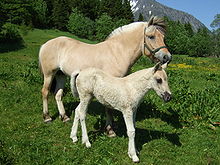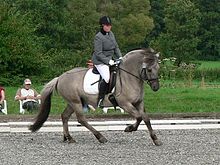

 | |
| Other names |
|
|---|---|
| Country of origin | Norway |
| Standard |
|
The FjordorNorwegian Fjord Horse (Norwegian: fjordhest) is a relatively small but very strong horse breed from the mountainous regions of western Norway. It is an agile breed of light draught horse build. It is always dun in colour, with five variations in shade recognised in the breed standard. One of the world's oldest breeds, it has been used for hundreds of years as a farm horse in Norway, and in modern times is popular for its generally good temperament. It is used both as a harness horse and under saddle.
The Fjord is one of the world's oldest and purest breeds. Horses were known to exist in Norway at the end of the last ice age. It is believed that its ancestors migrated to Norway and were domesticated over 4000 years ago. Archaeological excavations at Viking burial sites suggest that horses of this type have been selectively bred for at least 2000 years.[1][2] The horses were used by the Vikings as war mounts, and have been used for hundreds of years as farm animals in western Norway. Even as late as World War II, they were useful for work in mountainous terrain. Its strength, durability and thick coat fare well in the rough winters of Norway.[2]
The breed has a long history of pure breeding without cross-breeding from other sources.[2]
The conformation of the Norwegian Fjord Horse differs from that of many other breeds in that it is a blend of draught horse muscling and bone, with smaller size and greater agility. It has a strong, arched neck, sturdy legs and good feet, and a compact, muscular body. The head is medium-sized and well defined with a broad, flat forehead and a straight or slightly dished face, with small ears and large eyes.[1] Despite its small size, the breed is fully capable of carrying an adult human and pulling heavy loads. The hair coat becomes particularly heavy and thick in the winter.
The natural mane is long, thick, and heavy, but is usually clipped in a distinctive crescent shape to between five and ten centimetres (two to four inches) so that it stands straight up and emphasises the shape of the neck.[1] This roached mane is thought to make for easier grooming. It also accentuates the horse's strong neck and full-length dorsal stripe. There is some feathering on the lower legs; however, the breed standard discourages profuse feathering.[3]
There is no upper or lower limit for height set for the breed, but heights between 135 and 150 cm (13.1 and 14.3 hands; 53 and 59 inches) at the withers are recommended.[4] [2] The weight normally ranges from 400 to 500 kilograms (880 to 1,100 lb).[1]

Most of the horses are dun.[1][5] Dun is a body colour that is a tan, gold or related shade with darker (usually black or dark brown) points and primitive markings. The breed standard recognises five shade variations.[3] These shades have been officially recognised in Norway since 1922.[5] The hooves are most often dark, but can be a lighter brown colour on lighter-coloured horses.[3]
The dun colour itself is a dominant dilution gene. All the horses are dun; therefore they are homozygous or nearly so for dun colouration.[6]Noequine coat colour genetics studies have been done specifically on the horses; but if they were not homozygous for the dun gene, then a dark-coloured, non-dun individual could occasionally occur. However, this is very rare or non-existent today; dark cropouts existed in the past, but breed standardisation has favoured duns and the colour is now produced consistently.[5]

The primitive markings associated with the dun gene are often quite vivid. These include the dorsal stripe, darker mane and tail, horizontal stripes on the back of the forearms, and, in rare cases, transverse striping across the withers.[5] Some horses have small brown spots on the body or the head.[3] These spots are called "Njal marks" after one of the foundation sires of the breed, who had such markings.[5] The horses are also consistent for having pangare traits: lighter hair on the muzzle, belly, inside of legs, and over the eyes.[5] Some also carry the cream gene, which combines with the dun gene to create the lighter shades of the breed.[6]
The horses have a significant amount of lighter hairs on the outside edges of the mane and edges of the tail, and when teamed with the darker-coloured centre of the mane common to most colour shades gives a two-toned look that is more dramatic than seen in dun horses of other breeds.[7] The dark section of hair in the middle of the mane and the darker hair in the middle of the tail are described by the Norwegian terms midtstol and halefjær, respectively.[5]
White markings are rare,[5][8] but have been noted as long as written records have been kept of the breed.[5] A small star is acceptable,[3] but any other white or pink markings are considered undesirable.[5] Norges Fjordhestlag (The Norwegian Fjord Horse Association) decided in 1982 that stallions of any age with any other white markings than a small white star cannot be accepted for breeding.[5]

The breed standard recognises five colours. 90% of all the horses are "brown dun" (the colour called "bay dun" in other breeds).[1] The remaining 10% are either "red dun", "grey" (less often "grey dun", the colour known as mouse dun in other breeds), or two colours reflecting the influence of the cream gene: "white dun" (or "uls dun") and "yellow dun".[5] The breed association encourages preservation of all colours.[3] The dun colour variations can be subtle and hard to distinguish unless horses of different shades are standing side by side. The colour terms are also non-standard when compared to English terminology more commonly used to describe horse coat colours in other breeds. This difference appears to be based in part from being derived from Norwegian language terms, which were set in 1922, and their English translations, which were made official in 1980.[5] While these terms were set before equine coat colour genetics were fully understood, the variations do match up to modern genetic studies as variations of dun colour with the addition of other genetic factors.


Along with the recognised five shades of dun, two cream dilution alleles (CCr) on any other colour results in a horse with a light cream coat colour and blue eyes. This colour is called "kvit" ("white") in Norwegian, and is known as cremello, perlino or smoky cream in other breeds. A dun with double cream dilution will have faint or indistinguishable primitive markings.[8] In the Fjord, Kvit was traditionally considered undesirable, and thus is a very rare colour in the breed due to intentional selection against it.[8] Nonetheless, it is a normal colour within the gene pool, as the nature of cream genetics statistically will result in the occasional kvit horse any time two horses that both carry a single copy of the cream dilution are mated, such as an ulsblakk and/or a gulblakk.[6]

The Fjord is strong enough for heavy work, such as ploughing fields or hauling wood, yet light and agile enough to be a good riding and driving horse. It is also sure-footed in the mountains. It is common at Norwegian riding and therapeutic schools, as its generally mild temperament and small size make it suitable for children and disabled individuals. It is considered a good harness horse, and is commonly used in competition and in tourist transport.
The Norwegian Fjord Horse Centre (Norwegian: Norsk Fjordhestsenter) in Nordfjordeid is the national resource centre for the Fjord Horse in Norway. It was established in 1989 and is owned by the Norwegian Fjord Horse Association, Stad Municipality and the Vestland County authority.